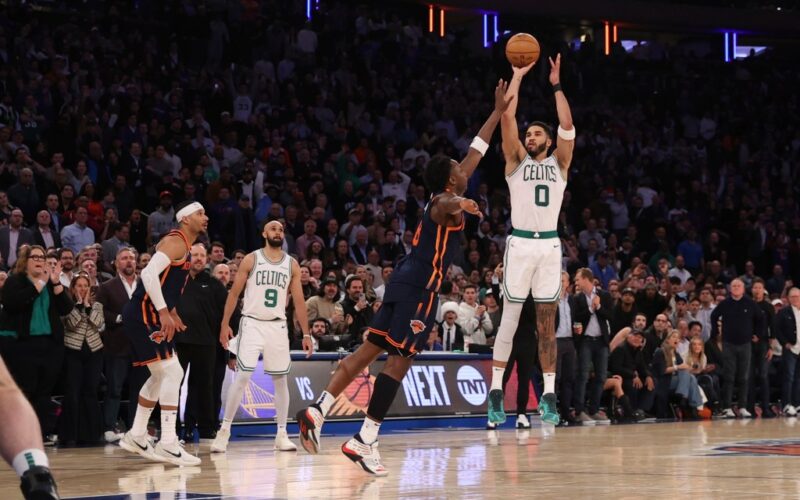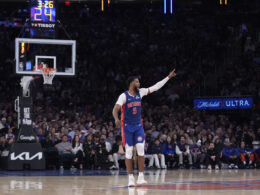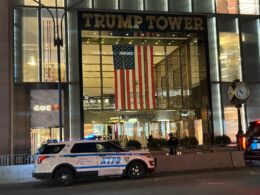The Detroit Pistons hoisted 188 threes across six games against the Knicks in the first round — the fifth-most attempts of any playoff team. They only made 61 of them. That 32.4% clip ranked bottom-five in the postseason.
The Boston Celtics are not the Pistons. They are the gorilla 29 other NBA teams are trying to take down, and they win by burying teams from behind the arc. To compound matters, the Celtics also dominate the offensive glass, which turns missed shots into even more threes on second-chance opportunities.
The Knicks survived Round 1 in part because Detroit couldn’t cash in on open looks. The Celtics do not offer such a margin for error. Which is why defending the three-point line will define this second-round series — and why a Knicks team that ranked near the bottom of the league in opponent three-point efficiency is a significant underdog entering the second round.
Because if the Knicks don’t guard the three, the Celtics will send them packing in four.
“They’re defending champions for a reason,” said Karl-Anthony Towns after practice in Tarrytown on Saturday. “They found a formula that works for them, it’s worked against the whole entire league, got them a chip. We just gotta go out there, execute, stay disciplined.”
Jayson Tatum is the head of the snake. Jaylen Brown is fully capable of hijacking a game — or a series. But what separates Boston from most elite offenses is what surrounds its stars: a barrage of knock-down shooters at every position. The moment Tatum or Brown forces the defense to rotate, the Knicks have to scramble, recover and contest — or risk a repeat of the regular season, where Boston went 4-0, including three blowouts, mostly by raining fire from deep.
“You have to finish your defense. It requires multiple efforts, it takes great communication, aggressiveness and you have to finish. You have to challenge, and then you have to rebound,” head coach Tom Thibodeau said Saturday. “They’re a great offensive rebounding team, and oftentimes, that leads to more threes. So they’re active pursuing the ball and they can create turnovers, which also leads to threes. So you have to have a great understanding of what’s going on in a game.”
That’s the hard part: reading the floor in real time and staying locked in. The Knicks have had lapses in that understanding for stretches at a time. They lost track of the hot hand with regularity during the regular season. And the Celtics don’t just shoot threes. They chase down their misses. They create turnovers. They flood the floor with spacing and punish every misstep.
The numbers tell the story: Boston tied an NBA record with 29 made threes in the season opener against the Knicks. Yes, it was ring night. Yes, it inflated the numbers. But it set the tone — the Celtics shot 19-of-39, 17-of-44 and 19-of-49 in their last three games against the Knicks.
Detroit generated its three-point looks primarily through Cade Cunningham. Boston’s offense comes at you from all angles. Dennis Schroder (48.7%) and Tobias Harris (43.5%) shot it well from deep, but Malik Beasley, who nearly won the three-point crown, shot just 9-of-34 (26%) from deep between Games 2 and 5, and Tim Hardaway Jr. shot it at a 30.8% clip from deep. Not to mention Cunningham connected on 17.9% of his looks from downtown.
The Celtics won’t bail the Knicks out in Round 2. They’ll aim to turn every defensive mistake into a backbreaking three.
“Obviously [we have to] keep bodies on bodies, not letting them loose for open threes,” said Jalen Brunson. “You have to contest everything and be ready for the long rebounds, the second shots.”
Boston is surgical. Sam Hauser, Kristaps Porzingis and Payton Pritchard all shot over 40% from deep. Derrick White, Al Horford and Jrue Holiday each landed between 35–38% — and all three will punish you if left open. Even Tatum and Brown, who finished below 35% overall, are lethal when it counts: Tatum shot 40% on catch-and-shoots, and Brown’s playoff resume includes long-range heaters that flip games in minutes.
“I think if you overlook guys like [Jrue] Holiday and [Derrick] White you’re making a big mistake,” said Thibodeau. “Those guys are all dangerous. [Kristaps] Porzinigis is a terrific player. You’re dealing with five-out spacing.”
There is a blueprint. Orlando gave Boston real issues from beyond the arc. The Magic held the Celtics to just 31.2 threes per game in Round 1 — down 17 attempts from Boston’s year average and more than five fewer than they attempted in three games against Orlando during the regular season.
Thibodeau said the coaching staff has been studying the Orlando-Boston series and New York’s own four regular-season games against the Celtics for improvement in this department. But reviewing the tape is one thing. Actually implementing what worked for the Magic is another ordeal. And for all of Orlando’s success defending the line, Boston still shot 37.8% as a team from downtown and ended the first round in a gentleman’s sweep.
“Of course you want to limit their 3-point attempts. It’s easier said than done,” said Towns. “You gotta go out there and make it happen. You can’t just talk about it.”
Talking time is up.
The Knicks just survived a first-round scare where they couldn’t consistently stay connected to Pistons shooters. If they’re that sloppy against Boston, they’ll get torched — again and again — by a team that’s built to live behind the arc.
And if the Celtics are getting clean looks? If the Knicks can’t fix an issue they’ve battled all year? Round 2 won’t just resemble the regular season. It’ll repeat it.
Four up, four down against the reigning champs, with Boston advancing behind the shot they’ve used to bury the league all year long.
Originally Published:








